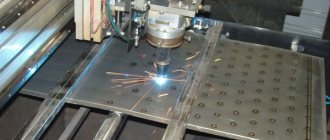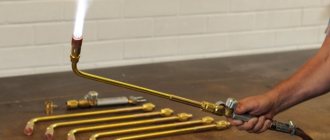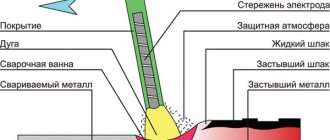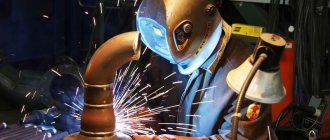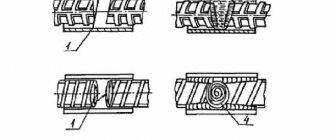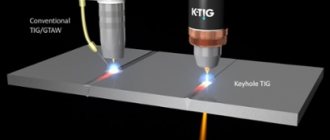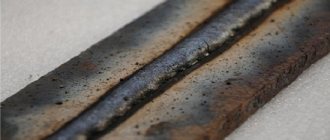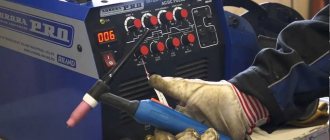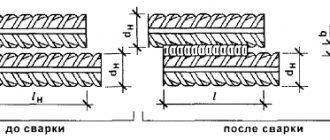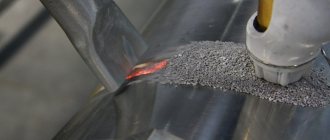First, let's look at the abbreviation MMA: this is Manual Metal Arc - manual arc welding with an inverter or through a transformer using electrodes. The old “Soviet” name was simpler and clearer: RDS - manual arc welding.
MMA welding is the absolute champion among welding technologies in terms of popularity among the general public for a long time. And the method itself is very old - it was invented at the end of the 19th century. MMA is simple and inexpensive - these are the two main criteria that place it on the honorable and well-deserved pedestal of people's love.
The essence of MMA welding
In order for MMA welding to occur, very little is needed: for a suitable metal electrode to melt. The possibility of using an electrode is determined by the type of coating, diameter, composition of the metal alloy of the rod - all these parameters are included in a fairly broad classification of welding electrodes.
The electrode coating protects the weld pool from the main enemy of high-quality welding - oxygen, which oxidizes the metal. The welding seam is formed by the melting rod, and the electrode coating turns into slag.
MMA welding technology.
You can cook using the MMA method using both direct and alternating current. If the current is constant, you can connect the clamp and holder in two ways, that is, you can work with both direct and reverse polarity. If the current is alternating, the electrode connection option does not play any role.
Currently, there are a huge number of welding machines in the form of inverters, among which you can find the most suitable version for yourself, taking into account your experience, the type of work planned, and so on.
Essence of the method
The arc is ignited between the edge of the base metal of the workpiece and the end of the melting coated electrode. Under the thermal influence of the arc, a weld pool forms on the part and the filler electrode melts, which, as it melts, is fed into the welding zone. The weld is formed as a result of mixing the base metal of the welded edges and the filler metal of the electrode.
Harmful impurities float to the surface of the weld pool in the form of slag. After complete crystallization of the weld pool, the slag crust is removed.
Protection of the molten metal from the harmful effects of the environment (oxygen and nitrogen) is provided by an electrode coating, which releases a protective gas when melted.
In addition, the electrode coating facilitates the ignition of the arc, maintains the stability of its combustion and contains slag-forming elements.
Basics of the Welding Process
The first step is to decide what type of current the work should be carried out on. Modern welding machines can operate at any current. You just need to take into account that it is more difficult to work with alternating current, because the electric arc is not very stable, and the welding seam may lose quality.
Therefore, the choice of current type will largely depend on professional experience: if you have it, you can work on AC. If you are at the beginning of the glorious path of a welder, your choice should remain direct current: it is easier to work with.
By the way, some metals or alloys can only be dealt with using direct current.
Reverse and direct polarity.
The connection polarity can also be of two types:
- Direct polarity occurs when the minus is connected to the electrode and the plus to ground. In this case, the direction of the current goes from the electrode to the part, which is heating up - in contrast to the electrode, which remains cold. Straight polarity is used in narrow areas, for example, when welding sheet metal.
- Reverse polarity means connecting the plus on the electrode and the minus on the ground terminal. In this case, the direction of the current goes in the opposite direction: from the metal to the electrode, which leads to heating of the electrode.
The next step is to decide on the correct current strength, which depends primarily on the thickness of the metal being welded. It is more convenient to calculate the current strength using the formula: 40 amperes for each millimeter of the thickness of the part. The current value is easily set: on the panel with a regulator.
Now it's time to light the electric arc - the main element of MMA. This stage can be called the most responsible and the most difficult. There are two ways to strike an arc: either by touching the end of the electrode and then sharply tearing it off, or by striking the electrode like a match.
The main thing is to get a stable and even arc; the quality of the weld in the end depends on this. First of all, to do this, the electrode must always be kept above the surface at the same distance - move it as evenly as possible. The distance should be optimal.
If you hold it higher than necessary, the arc will go out; if you hold it lower, the electrode will stick to the surface.
The welding process itself takes place in a weld pool. For it to form, the metal must warm up thoroughly; to do this, you can wrap the electrode a couple of times at the welding start point. The width of the weld pool must be adequate and the same width along the entire weld.
In order for all this to work out, you need, of course, practice. High-quality MMA welding can only be done by experienced craftsmen. For beginners, such requirements seem very difficult at first. But the method is learned quickly. After all, it is precisely because of its simplicity and accessibility that MMA is so popular both on construction sites and in summer cottages.
Welding types: MIG MAG TIG MMA
Welding allows you to obtain permanent connections that are exceptionally strong. This indicator at the seam must be no lower than the base material, which is achieved by strict technology requirements and the addition of alloying substances. In addition, this process is characterized by connection speed, complexity of the acceptable form, and the ability to control and vary basic parameters. MIG/MAG welding is developing most dynamically in industrial applications, but other types are also being improved. The choice of a specific approach is determined by a number of parameters:
- Material of the parts to be connected.
- Production conditions. MIG, MMA and TIG require different organization and production preparation. The set of necessary equipment can vary from a simple power source to a set that includes a feed mechanism with precise adjustment and a compressed gas cylinder.
- Quality requirements. MIG, MAG, MMA and TIG welding should not always be considered interchangeable - they have different capabilities, including in the formation of the weld.
- Personnel qualifications. The most accessible in this are MAG and MMA. However, RDS is noticeably more difficult with increased requirements and small dimensions: leg, width, height, etc.
- Expected performance. The semi-automatic and automatic process turns out to be much faster than the manual one. Depending on this, suitable types are considered and the optimal one is selected.
MMA
mma technology diagram
In our country, the definition of manual arc welding (and the abbreviation RDS) is common. It is cheaper and easier to organize production and less demanding on equipment.
The connection of two elements in MMA occurs using an electrode - a metal rod coated with a coating containing substances that help maintain the arc, protect the welding zone, and form a seam with the desired properties. When voltage is applied, a stable short circuit is formed between the rod and the workpiece, leading to their mutual melting.
The difficulty may come from requiring welder qualifications. To obtain a neat and reliable joint, skill and long experience are required.
In MMA, special attention is paid to the condition of the electrodes, which should not be wet or crumbling. Do not neglect pre-drying and checking.
MIG/MAG
Mig/mag technology diagram
The question of what MIG/MAG welding is should not be misleading, despite the unusual designation.
The English abbreviation MIG/MAG (MIG/MAG) hides the well-known semi-automatic welding with electrode wire in a shielding gas environment.
Instead of a rod, a thin wire acts as an electrode, which is semi-automatically fed into the zone where the weld is formed. This compensates for the melting process and simplifies the performer’s task.
Small diameter wire (from 0.8 to 3.0 mm) allows you to obtain compact connection sizes of a few millimeters.
Fundamentally, MIG differs from MAG in the type of protective gas, which is necessary for isolation from the environment with its high oxygen content in the air. Oxidative processes negatively affect the structure through the formation of intercrystalline rust. MIG welding involves the use of inert gas, which itself does not enter into any chemical reactions, but due to its relatively large weight, tends downward, displacing air. A local microclimate is formed, which shows good results.
MAG welding involves interaction between the natural and created environments, accompanied by the binding of oxygen.
TIG
Tig technology diagram
The decoding of this abbreviation leads to welding with a non-consumable electrode in an environment of inert gases. The main welding material used is thin, sharpened tungsten rods that are strong enough not to melt at operating temperatures. Wire is used as an additive, but its presence is not a prerequisite.
The argon-based protective environment not only sets the correct casting processes, but also creates a melting zone that is local and deep.
TIG is demanding on the level of the welder and on the equipment. Due to its minimal heating, it is usually used to work with aluminum or thin-sheet stainless steel. The same applies to MIG welding.
Flux
Among the types of arc welding, in addition to MIG MMA TIG, it is also worth mentioning that it proceeds under a layer of flux. What flux is has many variations. All possible materials have in common such qualities as flowability, the ability to influence the formation of a seam at all stages of remelting (including under unfavorable external conditions), and the ability to form a monolithic crust after cooling. The use of flux shows very good results, but complicates the process itself and implies additional costs. MIG, TIG and MAG are more economical and easier to implement.
Share with your friends
0
0
0
0
svarkalegko.com
Benefits of MMA
Welding metals with an electrode.
The advantages of electric arc welding are powerful and beyond doubt:
- The versatility of the technology: it can be used to weld almost any metal.
- You can cook in any position, including in confined spaces.
- MMA technology can withstand any adverse environmental conditions.
- Can be used at home, inexpensive components.
Disadvantages of MMA
In fact, all of the following disadvantages cannot be considered as such.
These are rather the properties of the technology that need to be taken into account:
- Relatively low productivity, especially in comparison with a semi-automatic machine.
- The technology requires professional experience.
- Difficult process of igniting the arc with the risk of sticking.
- Harm to health from fumes from the coating of certain types of electrodes during welding.
It should be noted that modern equipment helps to avoid troubles such as sticking of the electrode due to improper ignition of the arc. Many models are equipped with advanced “hot start” and “anti-stick” functions, which will make MMA welding more or less easy and accessible for beginners.
Of course, all the advantages of MMA welding many times outweigh its disadvantages. The accessibility and versatility of the method are undeniable. In addition, the cost of equipment for MMA is much lower compared to the prices of argon arc or semi-automatic welding machines.
Pros and cons of manual MMA arc welding
You should buy a welding machine only if you are firmly convinced that it will be in constant demand and will not add to the number of unnecessary items after one or several welding sessions. Like any other method of welding metals, MMA technology has its positive and negative sides.
Positive aspects of MMA:
- almost all types of metals can be joined;
- welding work can be performed in any spatial position and even in limited space;
- the device can be used under a wide variety of atmospheric conditions with the exception of precipitation;
- low cost of equipment, which allows it to be used in everyday life.
Disadvantages of MMA devices:
- Compared to a semi-automatic installation, it has low productivity;
- the level of the weld seam very much depends on the qualifications of the welder;
- the technological process is a rather complex process: the electrode may stick, difficulties arise when igniting the arc;
- the electronic coating may evaporate, which worsens the conditions for seam formation.
The disadvantages, if you get to the heart of the matter, are not even such. At least some of them. For example, relatively low equipment performance. Welding in most cases is not the main technological process, but only an auxiliary one. For example, in construction, welding takes up a very small share of the overall process. And even low-productivity equipment copes with the assigned tasks quite well. Automatic or semi-automatic installations in this case would be redundant from a productivity point of view.
As for the qualifications of a welder, alas, the human factor is of paramount importance in any production. And this is not a disadvantage of purely manual welding, but is relevant to any other technological process with human participation. In addition, nothing prevents specialists from improving their qualifications. In addition, developers and manufacturers are making great efforts to simplify the operation of welding machines. Most modern models are equipped with useful functions such as “anti-sticking”, “hot start” and others.
Against the background of the disadvantages, which in most cases are not a reason to refuse to use manual arc welding, the advantages are very significant. Being essentially universal equipment, MMA welding machines are used in different conditions and areas of production. Compared to semi-automatic and argon-arc welding machines, the devices are affordable and unpretentious in operation.
Welding equipment for MMA
Choosing a device for working using the MMA method is not an easy task due to the numerous models offered on the market. You need to understand this abundance. Therefore, some tips regarding equipment for MMA:
Transformers
Inverter device for MMA welding.
Veterans of the welding movement are unpretentious, inexpensive, heavy, large in size, and can only be controlled manually. These are, of course, stationary devices.
The essence of their action is the conversion of mains current into welding current using a coil - a core with windings of metal wire. You need to cook on alternating current.
Welding rectifiers
Devices for converting alternating current into direct current. With direct current, welding seams are formed smooth, neat and strong, and this is the most important thing in welding.
Rectifiers are close relatives of transformers, especially in terms of their size and heavy weight. To work on them you need practical welding skills.
Inverters
Here is the best choice of a modern device from all points of view. With inverters, RDS becomes accessible, simple and effective even in the hands of beginners. There is no coil in them; the action is based on an electronic plate with a built-in rectifier.
The output already produces a direct current with adjustments to its stability.
The vast majority have advanced functions that help avoid electrode sticking and help with quick ignition of the arc.
Inverters are compact, lightweight and movable. The inverter can even be hung on your shoulder.
Technology
The first step is to set up the mma welding mode. It is important to do this correctly so that later there are no difficulties when welding. The process is within the power of a true master; a beginner can try to do everything correctly with some effort.
After this, the arc is ignited. The process is possible either by striking or tapping. In the first case, you need to run the metal along the metal level, in the second, tap the end of the electrode on the structure.
This can be difficult for a newbie without at least two years of experience. But everything comes with practice. After 2-3 months of regular work, you will be able to light an arc without effort.
For stable arcing, it is important to keep the electrode a few millimeters from the metal. At a large distance, the arch may go out, and if it comes into contact with metal, it may stick to it.
Ensure that the metal is heated. To do this, move the electrode in a circular motion. A weld pool is formed in front of you, the size of which should be the same throughout the entire seam.
After the structure is heated, it is important to move the electrode at a medium pace. Make sure the seam is formed evenly. The entire process must be free of visible defects.
